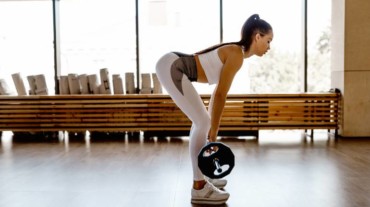
Do you want to up your weightlifting game? You can include sumo deadlift into your fitness routine.
All fitness enthusiasts love to build muscles and incorporate many weightlifting and strength training exercises into their fitness regimen. While most exercises are good, you must add sumo deadlifts to your workout routine if you want to level up your weightlifting game. Sumo deadlifts are considered an excellent weightlifting variation that helps improve your balance and stability. This exercise helps you lift more weight and is gentler on your lower back because it requires a wider foot stance that helps you balance properly. Here are the benefits of sumo deadlifts and how to do this exercise.
What is a sumo deadlift?
Sumo deadlift is a variation of the traditional deadlift exercise, wherein the lifter takes a much broader stance with his or her feet. For this exercise, legs are stretched wider than shoulder-width apart and their hands are kept between the knees as they grip the barbell. This stance resembles the position sumo wrestlers take, which is why it is called a sumo deadlift.

What are the benefits of sumo deadlift?
Here are some potential benefits of sumo deadlifts as explained by the fitness expert, Yash Agarwal.
1. Builds muscles and strength
If you include sumo deadlifts effectively into your training regimen, they’re an excellent way to build strength and muscle. They engage the quadriceps, glutes, hamstrings, and calves, developing leg and back muscles that will enable you to lift maximal loads.
2. Reduces back pain risk
Sumo deadlifts, unlike traditional deadlifts, impose less strain on the lumbar spine. This occurs because the back is virtually upright while the legs and core provide direct support during the raise. The legs take the strain off the spine, reducing the chance of back pain.
Also Read

3. Helps improve posture
Sumo deadlifts are a great option for those with back or flexibility problems, as well as bone abnormalities that make regular deadlifts unsuitable. The moment allows for a lot of mobility and efficiency while also working to improve posture and lower back strength. This is due to the wider stance and significant thoracic extension necessary for the exercise.
4. Strengthens glutes and quads
The wide stance and leg and foot posture work the quads and glutes more effectively than a traditional deadlift. As a result, these lifts are great for people looking to target these specific muscles.
5. Works multiple muscles
Compound exercises are exercises that work multiple groups at once. Sumo deadlifts work your lower and upper back in addition to your glutes and quadriceps. The lifts involve more energy from the body at the time and are beneficial for lean tissue growth, increased strength, and muscular building.
How to do sumo deadlifts?
Here is a complete guide to doing sumo deadlifts as explained by the expert.
- Step 1: Place the barbell on the ground, and stand wider than your shoulders.
- Step 2: Position your feet slightly wider than your hips.
- Step 3: Bend from the hips and knees to lower your torso in the direction of the bar, while maintaining a neutral spine and keeping your chest up.
- Step 4: Grip the bar with your arms while keeping them positioned between your knees.
- Step 5: Engage your middle muscles and pressure through your heels as you carry the barbell off the floor, extending your hips and knees simultaneously.
- Step 6: Keep the barbell near your frame for the duration of the raise, and keep your lower back stable.
- Step 7: As soon as you’ve fully extended your hips and knees, reverse the motion to lower the barbell back to the ground in a managed way.
- Step 8: Repeat for the preferred number of repetitions.
Here’s how to do deadlifts the right way to avoid painful back injuries

Are there any side effects of sumo deadlifts?
Although sumo deadlifts are generally safe if you maintain proper form, certain individuals should exercise caution or avoid them altogether:
- People with knee or hip injuries should visit a healthcare professional before incorporating sumo deadlifts into their routine.
- Individuals with restrained hip mobility or flexibility may find sumo deadlifts uncomfortable or hard to carry out efficiently.
- Beginners or the ones new to weightlifting need to be aware of mastering the right shape with lighter weights before progressing to sumo deadlifts with heavier loads.
- Pregnant women should seek advice from a certified health professional before attempting sumo deadlifts or any other strenuous workout.







